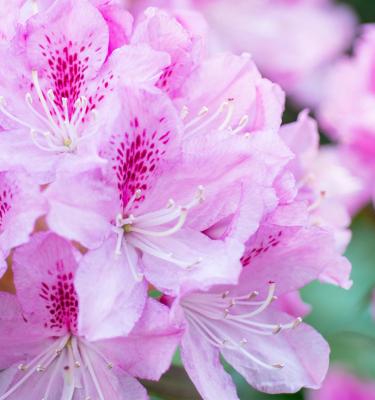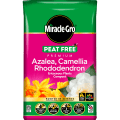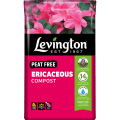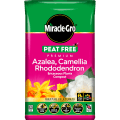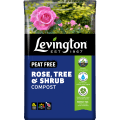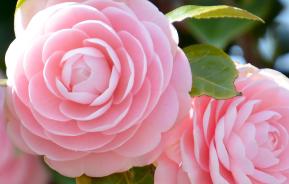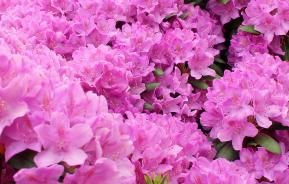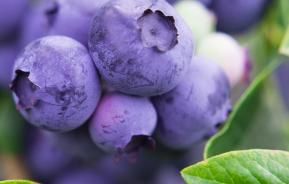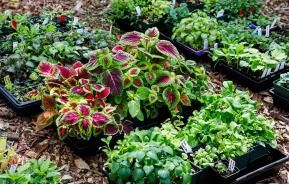Soil type can be acid, neutral or alkaline and is measured on the pH scale:
- pH of 4.5 – 6.0 indicates a more acidic soil.
- pH of 6.5 – 7.0 is known as a neutral soil and will benefit most plants.
- pH of 7.1 – 8.5 indicates an alkaline/lime-based soil.
Ericaceous plants are plants that don’t like growing in alkaline. Alkaline soils are typically derived from chalk and limestone, and ericaceous plants, also known as ‘acid lovers’ or ‘lime haters,’ won’t grow well in soils that have a high pH.
If you try to grow ericaceous plants in alkaline or limey soil, they produce yellow leaves. This is a condition known as lime-induced chlorosis and they don’t grow or flower well then usually finally die. The main reason for this is that iron and other soil nutrients they need become insoluble or ‘locked up’ in the soil at high pH so the plants are unable to absorb them.
If your soil is alkaline, you could try digging a large hole and lining it with plastic sheeting, making some drainage holes in the plastic, and then filling with a lime-free soil or a peat-free ericaceous compost. However, although over the first year the results may be promising, eventually the added ericaceous soil will be leached away and then the plant will start to suffer.
What is ericaceous compost?
Ericaceous compost is compost that has been specially formulated for those plants that prefer an acidic soil. It will often be formulated with added iron and magnesium to help with glossy green growth.
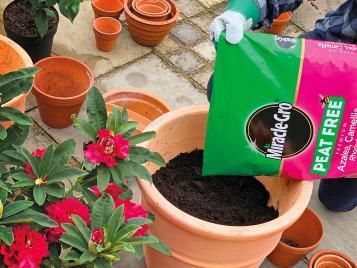
If your soil is naturally alkaline, rather than trying to change the soil type which is a long, costly and often unsuccessful process, it is much better and easier to grow ericaceous plants in large pots filled with a good quality peat free ericaceous (lime free) compost.
Growing ericaceous plants in containers also allows you to grow them in the right place in the garden. Most of the plants listed below (apart from Calluna and blueberries) prefer a position in light shade or out of direct sunlight - especially early morning sunlight, which can cause the flower buds and flowers to turn brown and drop off.
Growing ericaceous plants in containers
It is much better and easier to grow ericaceous plants in large pots filled with ericaceous (lime free) compost. Growing ericaceous plants in containers also allows you to grow them in the right place in the garden. Most of the plants listed (apart from Calluna and blueberries) prefer a position in light shade or out of direct sunlight - especially early morning sunlight, which can cause the flower buds and flowers to turn brown and drop off.
Good feeding
The other thing you need to ensure for, healthy growth, especially those grown in containers, is to feed the plants with a suitable fertiliser. Although many plants can be fed with a general-purpose feed, ericaceous plants really do much better if fed with a specific ericaceous plant feed. These contain all the specific nutrients needed for glossy green leaves and bountiful blooms.
They can be fed with a granular feed or a liquid feed. Continuous release granular feeds are perfect for those who lack time to feed regularly as they feed for up to six months from one application. Liquid feeds are more suited to those who love the routine of regular feeding and are especially good for those plants grown in smaller containers.
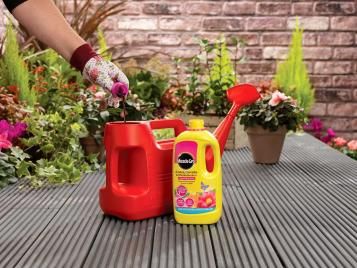
Water ericaceous plants well
Because most ericaceous plants - especially rhododendrons, azaleas, camellias, and heathers - are shallow rooted, they are prone to drying out during prolonged dry periods, so it is very important to keep the soil or compost moist. This is particularly important during the flower bud setting period in summer. If the soil or compost is allowed to dry out at this time bud set can fail. Ideally, water plants weekly during dry periods and mulch the soil well to preserve moisture.
Ericaceous plants and other acid lovers
Ericaceous is a plant family and this group is split into lime haters and acid lovers.
Lime haters are plants that will not do well in an alkaline soil or in an all-purpose peat free compost rather than a specially formulated ericaceous peat free compost. The plants will seem fine for the first season but gradually the plant will be unable to access the nutrients they need, and the first noticeable signs will be a yellowing of leaves, known as a lime induced chlorosis.
It's always best to plant the lime haters in a large container filled with a good peat free ericaceous compost rather than trying to add ericaceous compost to an alkaline soil.
Lime hating plants include:
- Azalea
- Blueberry
- Camellia
- Enkianthus
- Gaultheria
- Heathers (Calluna)
- Pieris
- Rhododendron
The acid-loving group of plants will tolerant some alkalinity in the soil and although they might not reach their full potential unlike the lime haters they will survive. If planting any of this group in containers, I would always recommend using a good peat free ericaceous compost and feed with a special ericaceous plant feed.
Acid-loving plants include:
- Acer (Japanese maple)
- Hydrangeas (some varieties)
- Magnolia (except M. x loebneri and M. stellata)
- Raspberries
- Skimmia
Its always a good idea before planting up a garden to check your soil pH type. You can buy a simple testing kit from garden centres or on-line and this will tell you if your soil type is acidic, neutral, or alkaline. Once you know your soil type you will then be able to make sure that your garden will thrive rather than just survive.
